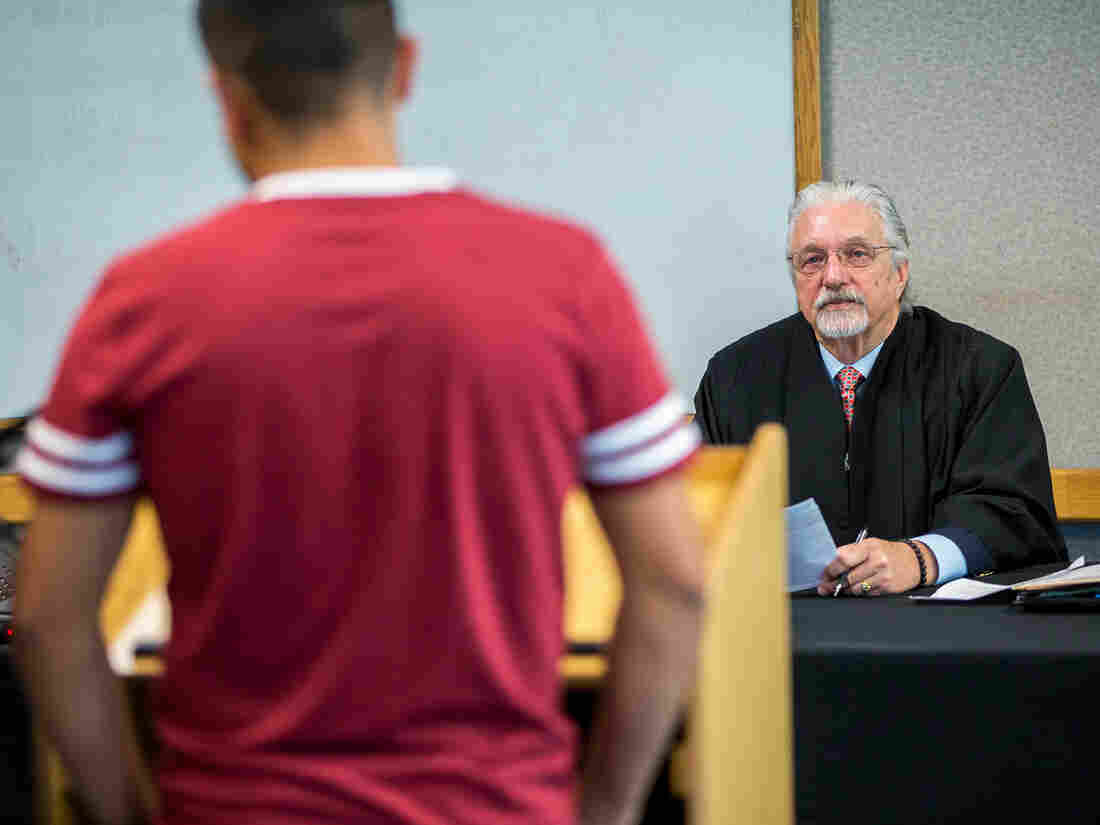April Ross (left), watches her U.S. teammate Kerri Walsh Jennings try to reach the ball during a women’s beach volleyball semifinal match early Wednesday. The Americans lost in straight sets to the Brazilians, 22-20 and 21-18, ending Walsh Jennings’ quest for a fourth straight gold. Petr David Josek/AP hide caption
toggle caption Petr David Josek/AP
Kerri Walsh Jennings’ quest for a fourth straight gold medal in beach volleyball was derailed as she and her fellow American April Ross were beaten in straight sets by Brazil early Wednesday.
Walsh Jennings won three golds with her previous partner Misty May-Treanor, who retired after the London Games in 2012. Walsh Jennings, 38, then joined forces with Ross and the top-ranked Americans were cruising through the tournament until they ran into second-ranked Brazilians Agatha Bednarczuk and Barbara Seixas.
Before a raucous crowd on Copacabana Beach, the first set was marked by repeated ties and lead changes. But the Americans, who had overpowered several opponents, met their match in Brazil.
Bednarczuk and Seixas made repeated diving saves on spikes by the Americans, extending rallies that the Brazilians often won with touch shots. With the score tied 20-20, the Brazilians took the next two points for a 22-20 first set win.
In the second set, the Brazilians jumped to a 5-2 lead and the Americans could never even the score. The Brazilians won 21-18 in a match that ended around 1 a.m., and the mostly Brazilian crowd exploded with joy.
The Brazilians will play Germany for the gold.
Here are the other highlights from Tuesday:
Simone Biles finishes with fourth gold
In this multiple exposure photo, Simone Biles performs in the floor exercise, where she won gold in Rio on Tuesday. Biles won four golds and a bronze overall, the best Olympic performance ever by an American gymnast. Julio Cortez/AP hide caption
toggle caption Julio Cortez/AP
Biles’ spectacular run at the games concluded just as they began — with a sterling performance, a dazzling smile, and a gold medal dangling from her neck.
Biles won the floor exercise, giving her a fourth gold to go with one bronze out of the six available medal events in women’s gymnastics (She didn’t compete in the sixth, the individual uneven bars).
The 19-year-old became the first women gymnast to win four gold medals since Romania’s Ecaterina Szabo did it in 1984.
“I’m a little bit relieved because it’s been a long journey,” Biles said after her victory.
Aly Raisman, who won gold in London four years ago in the floor, took the silver. Raisman was overshadowed by Biles in Rio, just as she was by Gabby Douglas in London. Yet Tuesday’s medal gave Raisman three medals in these games, to go with three in London, making her one of the most decorated gymnasts in U.S. history.
On the men’s side, American Danell Leyva took two silver medals Tuesday, one in the parallel bars, the other on the high bar. Combined, the U.S. men and women will return home with 12 medals, their best showing ever.
Our full gymnastics story is here.
Jamaicans rule the sprints, Kenyans dominate distance races
Jamaica’s Omar McLeod (center), wins the 110-meter hurdles in Rio on Tuesday night. This was the third Jamaican sprint title already and they are favored in more later this week. Martin Meissner/AP hide caption
toggle caption Martin Meissner/AP
There’s a clear trend in track at the Rio Games: The Jamaicans have won three sprints in recent days and the Kenyans have done the same in the distances, with both countries poised to claim more.
Omar McLeod gave Jamaica its first gold in the 110-meter hurdles in 13:05, while the Americans got shut out from the medals for the first time ever. Devon Allen was the top U.S. finisher in fifth.
Jamaica’s Usain Bolt, who won the 100 meters on Sunday night, easily won his heat in the 200 meters on Tuesday, coasting the last 50 meters or so, finishing in 20.29. The final for that event is Thursday.
Jamaica’s Elaine Thompson, who captured the women’s 100 meters on Saturday night, advanced Tuesday to the finals of the 200 meters, where’s she’s also expected to be a medal contender.
One of the perennial duels at the Olympics is between the Jamaican and American sprinters, consistently the two best teams in the world. So far, the Jamaicans have dominated.
A similar rivalry exists in the distances between the Kenyans and the Ethiopians, and so far the Kenyans have the upper hand.
Kenya’s Faith Kipyegon crosses the line to win the women’s 1,500 meters. Kenya has won three distance races in the past three days. David J. Phillip/AP hide caption
toggle caption David J. Phillip/AP
In the women’s 1,500 meters, Kenya’s Faith Kipyegon pulled away from the reigning world champion, Ethiopia’s Genzebe Dibaba of Ethiopia to win the Olympic women’s 1,500 meters in a time of 4:08:92. Jenny Simpson of the U.S. took the bronze, the first time an American woman has ever medaled in the event.
One night earlier, Kenya’s David Rudisha ran away from the field in the 800 meters, defending his title from London in a time of 1:42:15. And on Sunday, Kenya’s Jemima Sumgong won the women’s marathon in 2 hours, 24:04 minutes.
Ethiopia’s one moment of glory so far was Almaz Ayana’s win in the 10,000 meters, where she shattered the world record by 14 seconds.
American Will Claye climbs back to the track after proposing to his girlfriend in the stands. He went into the crowd to propose right after he won the silver medal in the triple jump on Tuesday. Matt Slocum/AP hide caption
toggle caption Matt Slocum/AP
Rio romance
American Christian Taylor successfully defended his triple jump crown on Tuesday, but most of the media attention was directed toward runner-up Will Claye, who repeated his second-place finish in London.
After Claye hopped, skipped and jumped his way to silver, he leaped into the stands and proposed to his girlfriend Queen Harrison, who said ‘yes.’
This is clearly a trend in Rio. On Sunday, Chinese diver He Zi won a silver medal, and immediately received a proposal from her boyfriend, Chinese diver Qin Kai, who had earlier won a bronze.
And last week, Marjorie Enya, the girlfriend of Brazilian rugby player Isadora Cerullo, asked Cerullo to marry her after a match. And British racewalker Tom Bosworth proposed to his boyfriend on Copacabana Beach.
Mutual support in the woman’s 5,000
It was just one of the heats of the women’s 5,000 meters, but it produced a memorable act of sportsmanship.
Near the back of a tight pack of runners, New Zealand’s Nikki Hamblin fell, and trailing right behind, U.S. runner Abbey D’Agostino tripped over her.
But rather than carry on, D’Agostino turned to Hamblin and encouraged her to get up. She did, and as they resumed running, far behind everyone else, D’Agostino’s right knee gave way and she collapsed to the track.
This time Hamblin stopped and turned to D’Agostino and urged her on. But D’Agostino couldn’t immediately carry on.
Hamblin then made her way to the finish, and D’Agostino limped along behind her to the line. She then collapsed again, and was then taken off in a wheelchair.
Because they both fell, they will be allowed to compete in the final, though it was not clear whether D’Agostino will be able to compete.
Let’s block ads! (Why?)













